|
FAQs about Non-Vertebrate Animal
Identification
35
Related Articles: Marine Invertebrates, Marine Invertebrate Systems, Marine Invertebrate Compatibility,
Marine Invertebrate Disease,
Marine Invertebrate
Reproduction, Quarantine of Corals and
Invertebrates, Feeding
Reef Invertebrates, Lighting
Marine Invertebrates, Water Flow, How Much
is Enough,
Related FAQs: Non-Vert IDs 1, Non-Vert IDs 2, Non-Vert IDs 3, Non-Vert IDs 4, Non-Vert IDs 5, Non-Vert IDs 6, Non-Vert IDs 7, Non-Vert IDs 8, Non-Vert IDs 9, Non-Vert IDs 10, Non-Vert IDs 11, Non-Vert IDs 12, Non-Vert IDs 13, Non-Vert IDs 14, Non-Vert IDs 15, Non-Vert IDs 16, Non-Vert IDs 17, Non-Vert IDs 18, Non-Vert. ID 19, Non-Vert. ID 20, Non-Vert. ID 21, Non-Vert. ID 22, Non-Vert. ID 23, Non-Vert. ID 25, Non-Vert ID 26, Non-Vert ID 27, Non-Vert ID 28, Non-Vert ID 29, Non-Vert ID 30, Non-Vert ID 31, Non-Vert ID 32, Non-Vert 33, Non-Vert ID 34 Non-Vert ID 36, Non-Vert ID 37, Non-Vert ID 38, Non-Vert ID 39, Non-Vert ID 40, Non-Vert ID 41, Non-Vert ID 42, Non-Vert ID 43, Non-Vert ID 44, Non-Vert ID 45, Non-Vert ID 46, Non-Vert ID 47, Non-Vert ID 48, Non-Vert ID 49, Non-Vert ID 50, Non-Vert ID 51, Non-Vert ID 52, Non-Vert ID 53, Non-Vert ID 54, Non-Vert ID 55, Non-Vert ID 56,
Non-Vert ID
57, Non-Vert ID 58,
Non-Vert ID 59,
Non-Vert ID 60, Non-Vert ID 61,
& Marine Invertebrates, Marine Invert.s 2, Marine Invert.s 3, & FAQs about:
Marine Invertebrate Behavior,
Marine Invertebrate
Compatibility, Marine
Invertebrate Selection, Marine
Invertebrate Systems, Feeding
Reef Invertebrates, Marine
Invertebrate Disease, Marine
Invertebrate Reproduction, &
& LR
Life Identification, LR
Hitchhiker ID 1, Anemone
Identification, Aiptasia
Identification, Aiptasia ID 2,
Worm Identification, Tubeworm ID, Polychaete Identification, Snail Identification, Marine Crab
Identification, Marine Invert.s 1,
Marine Invert.s 2, Marine Plankton,
|
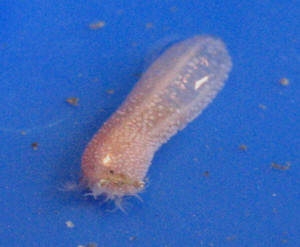
|
| Pest anemone? Mmm, no
05/21/08 Hi, Wet Web. I am starting to get over
run with a little pest. They are about the size of a pencil eraser
and only live in the shade. Please see the pic I attached. It looks
like a volcano or round tube with some tentacles at the top. I
can't seem to find a similar pic or article anywhere. Please
help. I have a 6 month old reef tank with 200 pounds of Fiji live
rock. Thanks as always, you guys are the best! Joe. <Is a
Syconoid sponge... no worries. See WWM re (the search tool,
indices). Cheers, Bob Fenner> |
|
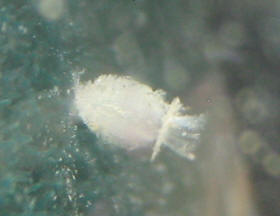
|
Acropora W/Feather Duster Type Thing?
(Nope'¦Sounds Like Neat Little Barnacles To Me) --
05/16/08 Good late evening/early morning WWM crew:
<<Greetings'¦is late Friday evening here now>> I
recently made a purchase at a LFS that has me worried.
<<Uh-oh>> I bought what appeared to be a small 2"
Acropora frag, species unknown. I inspected the coral thoroughly in the
store's tank, but the main 400 watt halides had yet to come on
(only actinic lights and the ceiling lights on at the time). Not seeing
anything unusual, I had the employee bag it up and took it home. After
a few stops along the way (90 mile drive from store to house), I got
home and placed the coral still in bag in my sump to temp acclimate. I
forgot about the coral and went out to dinner; arriving home several
hours later and began acclimating it to the tank's water. All in
all, the coral was in the bag for no more than 8 hours.
<<Okay>> After several scoops of tank water into the bag, I
proceeded to dump half the water out and repeat; this process went on
for approx 45 min, all the while I was prepping the rubble that I
wanted to attach the frag to and clearing a spot on the sand bed to
place the newly acquired piece (I know; no QT is bad, I'm shaming
myself for it now). <<Lesson learned then>> By the time I
was ready to attach the frag my main lights were out for the night, so
I glued the frag to rubble and again, gave the coral a thorough visual
inspection while out of water waiting for the super glue to set. After
a few minutes, I returned the coral to my specimen container with tank
water to make sure it wouldn't fall off (need to find a better
glue, but that's for a different discussion). After another few
minutes, I placed the coral in the center of the tank on the sand bed
and called it a night. The next day, the polyps were extended on half
of the coral; the other half, where polyps should be, there were larger
holes with fan/feather type extensions that would open and close.
<<Ah! Barnacles! It is not uncommon to see Acropora species
hosting the interesting creatures>> In appearance, somewhat
similar to the webbed-appendages on a porcelain crab that they use to
catch particulates in the water column. <<Yes indeed>>
These fan/feather things react to food; I tested with feedings of
Cyclopeeze to which their movement in and out increased dramatically.
They are almost completely transparent and not only do they move in and
out of the holes in the coral's skeleton, they can rotate 360
degrees when extended. <<How lucky you are'¦ Do watch
and enjoy these organisms'¦while they last>> In
searching through the internet and WWM, I came across a question from
another hobbyist to which Adam replied that the critter in question was
a Aeolid nudibranch. <<Mmm, nope'¦not in this instance
in my estimation'¦is a barnacle by your description>>
While the affected coral in question is clearly not a Montipora (to me
at least, wish I had a digital camera to get a picture for you to
confirm), <<Me too!>> how much risk is there that this can
spread to my other small-polyped stony corals? <<Virtually
non-existent'¦ You will be lucky if these filter-feeding
organisms survive for more than a few months in captivity, much less
propagate>> Or what I should ask first is: do I in fact have a
nudibranch infected coral or is it possible that the coral frag grew
over some other sort of deceased coral skeleton to which these fans
were still attached? <<No'¦you have nothing to fear
here>> I have seen feather dusters great and small; but my eyes
have seen none that grow from within a SPS coral.
<<Indeed>> And I am positive that there were no white
spots, lesions or other signs of damage to the coral when
purchased--the usual slight loss of tissue at the bottom where it was
recently fragged and subsequently grown directly in the sand bed was
the only visible thing wrong with it. Since acquisition on Monday,
there has even been a small amount of new tissue growth at the base as
an effort to encrust onto the piece of rubble. I have several
varieties/colorations of plating, encrusting and branching Montipora in
the tank, as well as pocillopora sp., Acropora sp. and pavona sp. Not
to mention numerous Zoanthids, palythoa, euphyllia sp. (2 diff specie);
short tentacle plate coral; 2 trumpet/candy cane corals; 2 gorgonians.
The tank in question is a 40 breeder with 20 L sump. Tunze 9010
skimmer; lighting 400 watt SE XM 20k halide; lots of macro for nitrate
removal; refugium on reverse light cycle from DT. Pair of modded Tunze
6025 powerheads and MJ 900 for added flow (1 or 2 additional Nano
Streams will be added once my tax return finally comes :). Current
readings are 1.024 sg; 7 dKH (always run on the "low" end
despite dripping saturated lime water at night and dosing 2-part
regimen daily); <<Perhaps trying a different test kit is in
order>> calc 400 ppm. I dose the 2-part solution according to the
mfg's recommendations to raise/maintain loss of 1 dKH loss of alk
and 10 ppm calcium per day. No detectable ammonia, nitrites, nitrates.
The coral was purchased Monday of this week. At the writing of this
letter it is 1:35 am on the East Coast. <<I too am on the East
Coast (SC)>> So far, none of my other corals have shown any signs
of stress, disease, loss of color; all show normal polyp
expansion/extension. <<This unexpected hitchhiker on your SPS
frag is no reason for concern>> Any advice is greatly
appreciated. <<Take a deep breath and enjoy them while they
last>> Thanks for all you do to keep hobbyists like me loving and
better understanding the beautiful and magnificent creatures we have in
our marine tanks. -Eric <<Is a pleasure to share. Eric
Russell>>
Please identify -05/16/08 I
have a newly established system...about 8 weeks old. Has 1" -
1 1/2" live sand with 65# of live rock. Currently have about
30 blue/red legged hermit crabs, 6 turbo snails, 3 emerald coral
crabs and 1 sand shifting starfish. The system has been pretty
stable with our current reads in normal range with the exception of
the ammonia at ..25 (curing some rock that was added about 1 week
ago). I am fairly new to reef systems as I haven't had any
salts set up for about 7 years and the changes have been
tremendous. Thank you for your website as it has certainly helped
me in the process and helped to identify some of the pests that
come. <cool> My question is that I have this little critter
that is growing on my live rock that I can't seem to identify.
I apologize as the photo probably isn't clearest. <I'm
sorry but the picture is much too blurry for an ID.> It never
moves from the rock that it is on and remains pretty much
stationary except when we close the cabinet below the tanks or look
at it closely (changes the intensity of the light) it closes up. It
is tear dropped shaped, maybe 1/4" overall length and has 4
"antenna" type fingers out of the top of it. It splits in
the center at the top when it opens up so that 2 fingers go to one
side and 2 go to the other. It also has a dark "hole" or
coloration to the middle. <Huh, sounds strange.> I hope that
helps....I'm not the best at describing things. Could you shed
some light into what you think it may be. Someone told me that they
thought it was an oyster, but, it doesn't have a hard shell. It
almost looks like the end of some type of worm. <Could be...
please do try to get a clearer photo.> Thanks for your help.
Michelle
<Best,
Sara M.> |
|
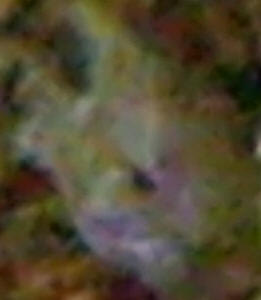
|
Re: Please identify
5/17/08 Sorry about the photo, here are a couple a little
farther off....as you can see it blends so well into the rock that
it is hard to distinguish it from the rock, but, it definitely
moves, closes shut really fast when light or movement is detected
(it is in the center of the first photo and a little farther
towards the bottom in the other). Does this help at all? <Yes,
thank you. It definitely looks like some kind of bivalve. I
can't ID it down much more specifically than that, but it's
probably a small oyster of some kind. Typically, they're quite
harmless and even enjoyable.> Sorry about the file sizes, I just
wanted to make sure you could see it better! <No problem>
Michelle
<De nada,
Sara M.> |
|
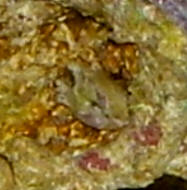
|
Critters I need ID'd, good or bad?
5/16/08 Greetings, I have 55 gallon reef tank with: green
brain coral, green and orange button polyps, green Zoanthids,
pumping xenia, 2 toadstools leathers, a torch coral, one large
condy anemone (in a spot by himself, not near my coral), and a
crocea clam. Fish include: yellow tang, two Percula clowns, green
clown goby, scissortail goby, coris wrasse, three chromis, and a
yellow headed sleeper goby. Also, a cleaner shrimp and a few
feather dusters. With that said, I have several tiny
"anemone" looking things spreading across my live rock
(critter4.jpg). <Possibly Aiptasia? I'm sorry, I can't
really tell from that photo.> I thought they were glass
anemones, but they are far too small and the largest they get are
about 3 mm. Any idea what they are? The second photo (critter3.jpg)
is of a little guy that keeps peeking out from under one of my
zoos. He is red with what looks like black hairs? <The pic is
pretty blurry, but it looks like a feather worm.> Again, any
idea what he is? I also have several little white spiral things on
my glass. <These are likely spirorbid worms.> Any help in
identifying these things would be great. Thanks, Jared
<Best,
Sara M.> |
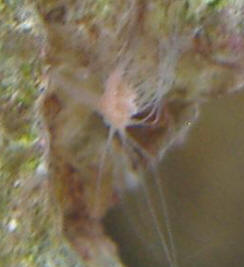 <maybe Aiptasia? <maybe Aiptasia?
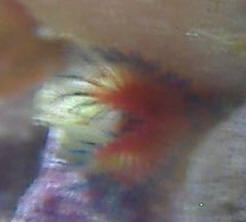 <feather worm <feather worm |
Saltwater Tank - Aiptasia?
5/16/08 Hello wwm, I got a saltwater tank for Christmas and
did all the necessary stuff to get it started etc. I have been
maintaining it well but lately I have noticed some weird stuff in the
tank. It is a 29 gallon biocube. Anyways there have been about 20 of
these...Anemone looking things with tentacles and they eat the food I
put in the tank. Do you have any idea what these are? They don't
really look like anemones more like these little bases with tentacles
coming out of it and a mouth sort of thing. <Could these be
Aiptasia?
http://www.wetwebmedia.com/marine/inverts/cnidaria/anthozoa/Aiptasia/aiptasia.htm>
Also there are two living barnacles in the tank that filter feed quite
often and was wondering if that will harm anything. My big concern is
these purple pinkish things that grow on the bottom of the tank on the
sand. they have a jelly looking base with these tentacle like hairs
coming up from it, <These sound like spaghetti worms.> Look like
tentacles made from fibers, is any of this bad or is it normal, or can
you identify them? thanks for the help <Hmmm... you have my guesses,
but it's impossible to truly ID these things without pictures.
Best, Sara M.>
| Medusa? --nope, sea cucumber ID-05/14/08
Hello guys and gals, I have a quick question for
you. . . Is this a Medusa worm? <nope> I have two of them to
my knowledge. I have searched and this sure sounds like a medusa
from what I've read, but I haven't seen any pics that
actually look like this. These things came with a little substrate
I got from the LFS to seed my tank with. They can contract to about
.5" and they actually will look like a peanut when all
shriveled up, but they can get about 2-3 inches long when expanded.
There are little tentacle things that are radically oriented in the
mouth. The tentacles are constantly feeling around for food and
help the thing to move around. Each tentacle also has smaller
tentacles on it. <'Tis a sea cucumber. Please see here:
http://www.wetwebmedia.com/seacukes.htm> I found them when I
dumped the substrate in, but I have them isolated outside of the
tank right now. I've read bad things about medusa worms and sea
cucumbers in tanks etc, so I'm not sure if I should allow these
to be in the tank. I have a 90 gallon fish/reef tank with a 20
gallon sump and an AquaC urchin skimmer. (I know, the skimmer is
undersized, but the bigger one wouldn't fit in the sump under
the tank!) <Congrats... they are cool critters. Enjoy!> Great
site, and thanks for the help! Scott S. Heck <De nada, Sara
M.> |
|
 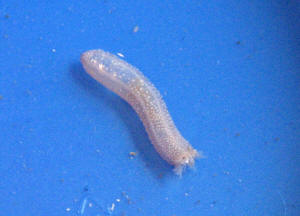
|
| Sea Cucumber--good
idea? bad idea? 05/14/08 Very cool, thanks for answering
what these things are! Can you tell me how large these particular
ones get? I assume there is still a decent amount of risk as far as
something making them mad and poisoning my tank? I'm a little
wary of putting them in after reading about them on your site!
<Oh, sorry about that. That article is more about the bigger
cucumbers that might be sold as pets. These little ones that come
in as hitch hikers aren't likely much of a threat. I
wouldn't worry about them. There are probably more in your tank
anyway (you might never even find them!). If you're really
worried, just run some extra activated carbon.> Thanks again!
Scott S. Heck <Best, Sara M.> Re: Sea Cucumber--good
idea? bad idea? 05/14/08 Sweet, in they go! Thanks again!
Scott S. Heck |
thousands of teeny tiny creatures on my
aquarium glass! 05/09/08 Hi WWM crew! Love your site. I
have a question. A couple weeks ago I noticed these little almost
microscopic white specks on my aquarium glass. I have a 29 gallon
freshwater aquarium. They almost looked like tiny white specks of
residue left from a paper towel I used to wipe the glass. But upon
further inspection they are moving! Slowly along the glass and some are
even floating in the water. These are tiny, minute creatures. I've
searched planaria but they are so small it is difficult to make out the
tell-tale shape of the usual planaria look - being worm like with two
protrusions on each side at one end. These are almost about the
thickness of a strand of baby hair. and the longest I've seen are a
little over 1/16 of an inch long. They are barely visible unless you
get close to the glass but there are thousands of them on the glass.
Are they copepods? They are so small..too small to even get a decent
photograph. I've noticed that the fish don't seem to mind and
are relatively unaffected. Are these something to worry about? I've
not added any new rocks or plants. I have a bamboo plant that has been
in the tank for about 8 months. I've done water changes and
vacuumed the gravel and tested the chemistry and everything seems
normal except ever since these have appeared the water has been pretty
cloudy. I feed my fish once a day, and only the amount they can eat in
10 minutes. Do you know what these could be? - thanks <Annie, yes,
these are most likely copepods (or similar) if on the glass. Absolutely
harmless in themselves, but the fact they are growing at all indicates
they are finding lots to eat. Couple that with the cloudiness of the
water, and there's perhaps an over-feeding or under-filtering
issue. Fish need only sufficient food they eat in 1-2 minutes.
Honestly, it's better to err on the side of caution and feed too
little. Do also check your filter is up to snuff, perhaps starting by
rinsing the media once every 3-4 weeks. If needs be, upgrading the
filtration system. I always recommend a filter that offers 4 times the
volume of the tank in turnover per hour _at minimum_ for small
community tropicals, and at least 6 times the volume of the tank for
bigger fish like cichlids and goldfish. Cheers, Neale.>
| Re: What is this? Is it bad? It's a Chiton and it's
good! 5/5/08 <Hi Nick> Sorry I forgot to attach the pic
on the last one. <No worries. Thanks for the photos.
-Lynn> |
|
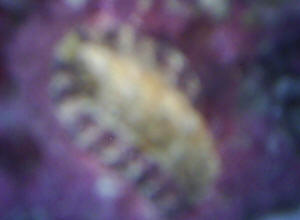
|
| Another weird ID Needed: ? - 5/5/08 <Hi Joe!> I am
bound to stump you guys. <I think you've succeeded with this
one! Or at least you've stumped me!> Not that I am trying,
but as luck would have it these oddities just keep popping up. This
time this little thing has popped up in a QT, nothing in it but a
maroon clown and the pic is of it growing off of a filter sponge.
<That's good to hear. When I first saw the photo, I thought
that was the substrate!> Notice the little cord type attachment
to the sponge. <I can just barely see a thin upside down
'V' shaped thing under it. I had to enlarge the photo to
see it. I do see another squiggly structure in front of the mystery
object, but it looks like a feather duster.> So far you guys are
3 for 3, I hope this can be 4. <I'm so sorry but I honestly
don't know what it is! My initial impression is that it could
be a sponge (possibly a Syconoid) of some sort. Although there are
some species of thinly stalked sponges (Glass sponges/Hyalonema),
I'd be very surprised if that's what this is. I think in
this case the cord could be throwing us off. This could be a
Syconoid attached to either a piece of fiber (with stuff growing on
it so it looks thicker), or part of a feather duster. Another
possibility is an Ascidian/sea squirt. There are some stalked
varieties, but the bases are thicker so scratch those. It could be
something like the Rhopalaea sp. shown at WWM
(http://www.wetwebmedia.com/ascidpt2.htm ) attached to a
fiber/duster, but note the obvious siphons and thin walls. I wish I
could see the surface of your mystery object a bit better. I
can't tell if it's fibrous, gelatinous, covered with
openings/siphons, or what. My last guess is that given the overall
shape and apparent bubbles of air/gas around the object, maybe what
we're seeing is the result of decay/bacterial activity. This is
out of my area, so bear with me -- I could be very wrong! Maybe a
piece of organic matter/food landed on the sponge (or something
died there) and was surrounded and consumed by bacteria. The
resultant structure may have initially developed into a small
sphere, but gas formed in the interior and it started to rise and
form this teardrop shape. That outside fuzzy area with the tiny
bubbles could be more bacteria -- a bloom around the outside.
Anyway, those are my best guesses.> Any info is appreciated...
Thanks in advance...Joe. <You're very welcome, Joe. I'm
sorry I couldn't give you a positive ID, but I just don't
have enough information. Take care and have a great week,
-Lynn> |
|
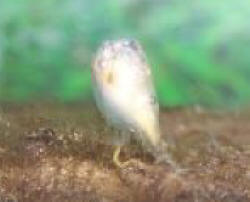
|
| Strange unidentified spongy thing -- 5/3/08 Hi,
<Lai> I noticed some stuff that came along with my live rock,
and it seems to have grown somewhat. I cant imagine what it could
be, but it looks like spongy eggs! Just wondering if you guys knew
what this is and if its bad for my tank? Should I try to get rid of
it. (no, its not the shrimp), the other 2 grey things... Lai ps.
Thanks in advance! You guys have been so helpful! <Mmm, looks to
be either an amorphous type Ascidian/Sea Squirt or some sort of
sponge itself. Not harmful... even beneficial in ways. Bob
Fenner> |
|
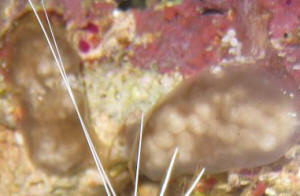
|
|
Algae, Sponge, Bryozoan? 4/28/08 Hi, <Howdy> I
just had a quick I.D. question for you guys.? I hope I'm not
wasting your time with this as I'm new to the hobby.? Thanks
in advance for any help you can give me.? I am attaching a
picture rather than ineptly trying to describe this.? Is this a
form?of?red coralline algae starting on my live rock?? <Mmm,
nah> I've been reading thought the many pages on your site
on saltwater aquariums and more specifically those pertaining to
reef tanks and frankly I'm hooked.? The hardest part at this
point is the patience required after reading about the many forms
of life that can sprout from my live rock.? I already have
several sponges, feather dusters and other tube worms that have
appeared on my rocks and can't wait for more to appear.?
Despite this sporadic life appearing, my rock seems somewhat
barren, but given the relative short time that I have had them
(six weeks) I have no doubt that I am being impatient once again.
Thanks for the help! both from your reply and the huge amounts of
information on your site) Ty <My guess from the pic alone is
that this is either a sponge or Bryozoan... Any change of a
closer up shot? Bob Fenner>
Re: Algae, Sponge, Bryozoan? 4/29/08
Hello again. Unfortunately the location of this critter makes it
kind of tough to get a closer picture.? Its location is in a
small cave.? The picture I sent is already pretty close in and is
at the max that my optical zoom goes on my camera.? The animal in
question is hard like the live rock if that helps in the ID.?
Also the roof of the cave it is in has a mass of stringy
filaments that I assume have nothing to do with this ID (probably
the feeding? lines of some worm?)? In any case? the stringy
stuff? never gets out of the? cave and has been building up on
the roof.? Should I reposition the rock so that the string can
get out of the cave? so the worm or whatever it is can
feed???Sorry i don't have any good pictures for you right now
as I am at work, but I can get some to you tonight when I get
home.? Once again thanks for the help.? Also I have cropped and
resized the original picture and attached it to this email.
Thanks, Ty <I'd leave all as is... this growth/organism is
no problem. Please fix your English before sending...
BobF>
|
|
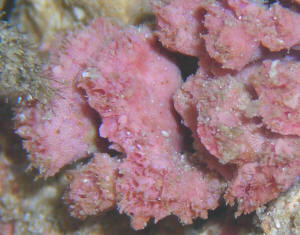
| Foramiferan ID 5/6/08 Sorry forgot to put the link
in Hi, I think I finally found something in regards to my
previous ID question.? I believe it is a foram, specifically
Homotrema rubrum. More information about these can be found
here http://www.reefkeeping.com/issues/2003-07/rs/index.php
.? Check out Figure 3. Can you confirm my guess?? Thanks for
all your help. <<Hello, yes i would concur with the ID
on this. Thanks, A Nixon>> Ty |
|
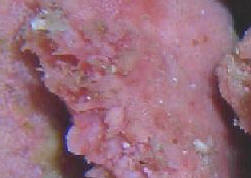
|
|
|
|

